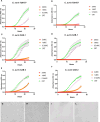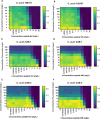In vitro activities of lipopeptides against fluconazole-resistant Candida auris
- PMID: 40013777
- PMCID: PMC11960442
- DOI: 10.1128/spectrum.01786-24
In vitro activities of lipopeptides against fluconazole-resistant Candida auris
Abstract
Candida auris has increasingly become a global threat due to its wide range of antifungal resistances as well as its ability to sustain outbreaks in clinical settings. Two lipopeptides, C14-NleRR-NH2 (Nel) and C14-WRR-NH2 (WR), were evaluated against six fluconazole-resistant C. auris isolates. Both molecules showed good antimicrobial activity as demonstrated by MIC determination, time-kill, and microscopy experiments. The peptides were able to inhibit fungal growth, while sub-MIC concentrations of the molecules delayed the growth. Moreover, the combinations of the two peptides with fluconazole demonstrated a reciprocal potentiation by checkerboard and time-kill experiments. Our results showed that antimicrobial peptides could be a promising option for the treatment of antifungal-resistant C. auris.IMPORTANCEAs well as antibiotics, also in fungal infections, antimicrobial resistance increased over the years. Moreover, in the last years, a new species emerged, Candida auris, as a nosocomial pathogen. C. auris possesses intrinsic resistance to common antifungals, such as azoles, that complicate therapeutic options. The combination of these two elements poses a risk for the treatment of fungal infections in the next years. The search for novel compounds with antimicrobial properties is crucial for the treatment of infections to overcome the increasing resistance of these etiological agents.
Keywords: Candida auris; fluconazole; in vitro activity; peptides.
Conflict of interest statement
The authors declare no conflict of interest.
Figures


References
-
- WHO fungal priority pathogens list to guide research, development and public health action. 2022
-
- Briano F, Magnasco L, Sepulcri C, Dettori S, Dentone C, Mikulska M, Ball L, Vena A, Robba C, Patroniti N, Brunetti I, Gratarola A, D’Angelo R, Di Pilato V, Coppo E, Marchese A, Pelosi P, Giacobbe DR, Bassetti M. 2022. Candida auris Candidemia in critically ill, colonized patients: cumulative incidence and risk factors. Infect Dis Ther 11:1149–1160. doi:10.1007/s40121-022-00625-9 - DOI - PMC - PubMed
-
- Chow NA, Muñoz JF, Gade L, Berkow EL, Li X, Welsh RM, Forsberg K, Lockhart SR, Adam R, Alanio A, Alastruey-Izquierdo A, Althawadi S, Araúz AB, Ben-Ami R, Bharat A, Calvo B, Desnos-Ollivier M, Escandón P, Gardam D, Gunturu R, Heath CH, Kurzai O, Martin R, Litvintseva AP, Cuomo CA. 2020. Tracing the evolutionary history and global expansion of Candida auris using population genomic analyses. MBio 11:e03364-19. doi:10.1128/mBio.03364-19 - DOI - PMC - PubMed
MeSH terms
Substances
LinkOut - more resources
Full Text Sources

